|
|
Creator | Title | Description | Subject | Date |
| 26 |
 |
Francis, John G. | HIV treatment as prevention: Not an argument for continuing criminalisation of HIV transmission | HIV prevention and treatment are undergoing impressive technological and practice changes. In-home rapid testing, prophylaxis before risky sex, and treatment as prevention give cause for remarkable optimism and suggest the possibility of an AIDS-free generation. These changes in HIV prevention and t... | | 2013-01-01 |
| 27 |
 |
Nicoll, Kathleen | Survey of earthquake preparedness actions | Survey on earthquake preparedness. | Earthquake preparedness | 2016-01 |
| 28 |
 |
Nicoll, Kathleen | The climate and environment of Byzantine Anatolia: Integrating science, history, and archaeology | This article, which is part of a larger project, examines cases in which high-resolution archaeological, textual, and environmental data can be integrated with longer-term, low-resolution data to afford greater precision in identifying some of the causal relationships underlying societal change. | | 2014-01-01 |
| 29 |
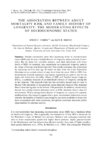 |
Smith, Ken R. | The association between adult mortality risk and family history of longevity: the moderating effects of socioeconomic status | Studies consistently show that increasing levels of socioeconomic status (SES) and having a familial history of longevity reduce the risk of mortality. But do these two variables interact, such that individuals with lower levels of SES, for example, may experience an attenuated longevity penalty by ... | | 2014-01-01 |
| 30 |
 |
Codding, Brian | Behavioral ecology and the future of archaeological science | The future of archaeological science relies as much (if not more) on theoretical as on methodological developments. As with anything in biology, explaining past human behavior will require the application of evolutionary theory. As with anything in archaeology, theory is useless without clear ties t... | | 2015-01-01 |
| 31 |
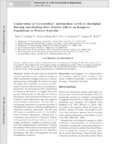 |
Codding, Brian | Conservation or co-evolution? Intermediate levels of aboriginal burning and hunting have positive effects on kangaroo populations in Western Australia | Studies of conservation in small scale societies typically portray indigenous peoples as either sustainably managing resources, or forsaking long-term sustainability for short-term gains. To explain this variability, we propose an alternative framework derived from a co-evolutionary perspective. In ... | | 2014-01-01 |
| 32 |
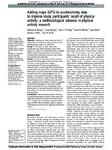 |
Brown, Barbara B. | Adding maps (GPS) to accelerometry data to improve study participants recall of physical activity: a methodological advance in physical activity research | Objective Obtaining the ‘when, where and why' of healthy bouts of moderate-to-vigorous physical activity (MVPA) provides insights into natural PA. Design In Salt Lake City, Utah, adults wore accelerometer and Global Positioning System (GPS) loggers for a week in a cross-sectional study to establis... | | 2014-01-01 |
| 33 |
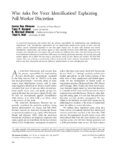 |
Hall, Thad | Who asks for voter identification? Explaining poll-worker discretion | As street-level bureaucrats, poll workers bear the primary responsibility for implementing voter identification requirements. Voter identification requirements are not implemented equally across groups of voters, and poll workers exercise substantial discretion in how they apply election law. In sta... | | 2014-01-01 |
| 34 |
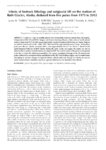 |
Forster, Richard R. | Effects of bedrock lithology and subglacial till on the motion of Ruth Glacier, Alaska, deduced from five pulses from 1973 to 2012 | A pulse is a type of unstable glacier flow intermediate between normal flow and surging. Using Landsat MSS, TM and ETM+ imagery and feature-tracking software, a time series of mostly annual velocity maps from 1973 to 2012 was produced that reveals five pulses of Ruth Glacier, Alaska. Peaks in ice ve... | | 2014-01-01 |
| 35 |
 |
Chandler, Julia | Mindfulness, Emotion Regulation, and Respiratory Sinus Arrhythmia: A Preliminary Investigation into the Effects of Mindfulness Instruction in a Complex Clinical Sample | Presented at the Undergraduate Research Symposium and the CSBS Research Day. Introduction Background • Emotion dysregulation is a risk factor for many forms of psychopathology (Vasilev et al, 2009). • Mindfulness based therapies, such as Dialectical Behavioral Therapy (DBT) are often effective ... | Mindfulness; Respiratory Sinus Arrhythmia; RSA; DBT; Emotion Regulation; Emotion Dysregulation | 2015-03 |
| 36 |
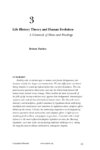 |
Hawkes, Kristen | Life history theory and human evolution : a chronicle of ideas and findings | Fertility ends at similar ages in women and female chimpanzees, but humans usually live longer and mature later. We also differ from our closest living relatives in weaning infants before they can feed themselves. The comparisons pose questions about when and why the distinctively human life history... | | 2006-01-01 |
| 37 |
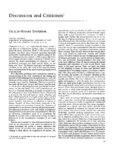 |
Hawkes, Kristen | On life history evolution (a comment on Chisholm) | Chisholm (CA 34:I-24) is right that the theory, models, and data of evolutionary biology apply to questions asked by social scientists. Work in life-history theory (Stearns 1992, Roff 1992, Charnov 1993) has especially provocative implications for the understanding of human development (see review i... | | 1994-01-01 |
| 38 |
 |
Hawkes, Kristen | The derived features of human life history | This chapter compares and contrasts the life histories of extant great apes in order to construct a hypothetical life history of the last common ancestor of all great apes and to identify features of human life history that have been derived during the evolution of our lineage. Data compiled from th... | | 2006-01-01 |
| 39 |
 |
Hawkes, Kristen | Grandmothers and their consequences | Both what we share and don't share with our primate cousins make us human. Easy enough to start a list. At least since Darwin, most would rate moral sentiments as distinctively human. But our modern selves didn't emerge from ancestral apes in one step. When did populations along the way become human... | | 2012-01-01 |
| 40 |
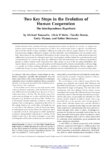 |
Hawkes, Kristen | Stag hunts or rearing environments? | Tomasello et al. have made the case that shared intentionality distinguishes humans from our nearest living relatives. What accounts for the difference? The answer they offer is Stag Hunt choices faced by ancestral foragers. Noting problems with that answer, I urge attention to a promising alternati... | | 2012-01-01 |
| 41 |
 |
Codding, Brian | Alternative aboriginal economies: Martu livelihoods in the 21st century | In the western deserts of Australia, hunting and gathering endures as an important social and economic activity. That foraging persists within the boundaries of developed industrialized nation states may come as a surprise to those who evaluate foraging as less profitable than agricultural, wage or ... | Aboriginal economics; Aboriginal foraging | 2015 |
| 42 |
 |
Utz, Rebecca L. | Feeling lonely vs. being alone: loneliness and social support among recently bereaved persons | Objectives: Despite increases in social support following widowhood, loneliness is among the most frequently reported challenges of bereavement. This analysis explores the dynamic relationship between social support and loneliness among recently bereaved older adults. Methods: Using longitudinal dat... | | 2014-01-01 |
| 43 |
 |
Forster, Richard R. | Ice surface morphology and flow on Malaspina Glacier, Alaska: Implications for regional tectonics in the Saint Elias orogen | The Saint Elias Mountains in southern Alaska are located at a structural syntaxis where the coastal thrust and fold belt of the Fairweather plate boundary intersects thrust faults and folds generated by collision of the Yakutat Terrane. The axial trace of this syntaxis extends southeastward out of t... | | 2014-01-01 |
| 44 |
 |
Wei, Y. H. Dennis | Urban land expansion and spatial dynamics in Globalizing Shanghai | Urban land expansion in China has attracted considerable scholarly attention. However, more work is needed to apply spatial modeling to understanding the mechanisms of urban growth from both institutional and physical perspectives. This paper analyzes urban expansion in Shanghai and its development ... | | 2014-01-01 |
| 45 |
 |
Codding, Brian | Codding, Brian: Living outside the box: An updated perspective on diet breadth and sexual division of labor in the Prearchaic Great Basin [Author's Manuscript] | A tremendous amount has been learned about the Prearchaic (before 9000 BP) Great Basin since we advocated a perspective of sexual division of labor based on Human Behavioral Ecology a decade ago. Many investigators have taken our advice and a few have challenged our assumptions and inferences. One o... | | 2014-01-01 |
| 46 |
 |
Bell, Adrian | Driving factors in the colonization of Oceania: developing island-level statistical models to test competing hypotheses (Electronic Supporting Material) | To test the model specification and fitting algorithms, we simulated data using randomly generated parameters, settlement chronology, and accessibility matrix for N islands. Using the function optim in R, we found the maximum likelihood estimates and compared them with the "true" parameter values us... | Oceania; Archaeology; Settlement; Statistical models | 2015-01-23 |
| 47 |
 |
Forster, Richard R. | Prevalence of pure versus mixed snow cover pixels across spatial resolutions in alpine environments | Remote sensing of snow-covered area (SCA) can be binary (indicating the presence/absence of snow cover at each pixel) or fractional (indicating the fraction of each pixel covered by snow). Fractional SCA mapping provides more information than binary SCA, but is more difficult to implement and may no... | | 2014-01-01 |
| 48 |
 |
Codding, Brian F. | Explaining prehistoric variation in the abundance of large prey: a zooarchaeological analysis of deer and rabbit hunting along the Pecho Coast of Central California | Three main hypotheses are commonly employed to explain diachronic variation in the relative abun dance of remains of large terrestrial herbivores: (1) large prey populations decline as a function of anthro pogenic overexploitation; (2 ) large prey tends to increase as a result of increasing social p... | Foraging; Resource depression; Prestige hunting; Paleoclimatic variability; Human behavioral ecology; Zooarchaeology; Central California | 2009-11-14 |
| 49 |
 |
Codding, Brian F. | Interpreting abundance indices: some zooarchaeological implications of Martu foraging | Indices of taxonomic abundance are commonly used by zooarchaeologists to examine resource inten sification, overexploitation and gender divisions in foraging labor. The original formulation of abundance indices developed a clear interpretive framework by linking the measure with foraging models from... | Human behavioral ecology; Zooarchaeology; Ethnoarchaeology; Resource intensification; Gender division of labor; Western Australia | 2010-07-20 |
| 50 |
 |
Codding, Brian F. | A land of work: foraging behavior and ecology | Work is a core theme in many of the major issues and debates in California archaeology. Work is central in understanding why the first Californians entered the region (e.g., Erlandson, this volume): how thousands of years of work following colonization resulted in the overexploitation of particular ... | Human behavioral ecology; Hunter-gatherer; North America: California | 2012-03-15 |

























